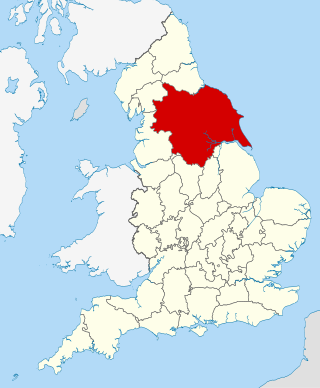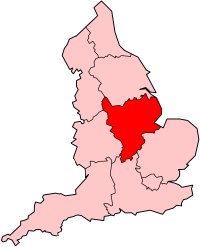Pitmatic is a group of traditional Northern English dialects spoken in rural areas of the Northumberland and Durham Coalfield in England.

Cumbria is a ceremonial county in North West England. It borders the Scottish council areas of Dumfries and Galloway and Scottish Borders to the north, Northumberland and County Durham to the east, North Yorkshire to the south-east, Lancashire to the south, and the Irish Sea to the west. Its largest settlement is the city of Carlisle, which is also its county town.
The phonology of the open back vowels of the English language has undergone changes both overall and with regional variations, through Old and Middle English to the present. The sounds heard in modern English were significantly influenced by the Great Vowel Shift, as well as more recent developments in some dialects such as the cot–caught merger.
Cumbric is an extinct Celtic language of the Brittonic subgroup spoken during the Early Middle Ages in the Hen Ogledd or "Old North", in what became the counties of Westmorland and Cumberland, and also Northumberland and northern parts of Lancashire and Yorkshire in Northern England and the southern Scottish Lowlands. It was closely related to Old Welsh and the other Brittonic languages. Place-name evidence suggests Cumbric may also have been spoken as far south as Pendle and the Yorkshire Dales. The prevailing view is that it became extinct in the 12th century, after the incorporation of the semi-independent Kingdom of Strathclyde into the Kingdom of Scotland.
Mackem, Makem or Mak'em is a nickname for residents of and people from Sunderland, a city in North East England. It is also a name for the local dialect and accent ; and for a fan, of whatever origin, of Sunderland A.F.C. It has been used by the people of Sunderland to describe themselves since the 1980s, prior to which it was mainly used in Tyneside as a disparaging exonym. An alternative name for a Mackem is a Wearsider.

The history of the Scots language refers to how Anglic varieties spoken in parts of Scotland developed into modern Scots.

Yorkshire dialect is a geographic grouping of several dialects of English spoken in the Yorkshire region of Northern England. The varieties have roots in Old English and are influenced to a greater extent by Old Norse than Standard English is. Yorkshire experienced drastic dialect levelling in the 20th century, eroding many traditional features, though variation and even innovations persist, at both the regional and sub-regional levels. Organisations such as the Yorkshire Dialect Society and the East Riding Dialect Society exist to promote the survival of the more traditional features.
Northumbrian was a dialect of Old English spoken in the Anglian Kingdom of Northumbria. Together with Mercian, Kentish and West Saxon, it forms one of the sub-categories of Old English devised and employed by modern scholars.

The spoken English language in Northern England has been shaped by the region's history of settlement and migration, and today encompasses a group of related accents and dialects known as Northern England English (or, simply, Northern (English) in the United Kingdom).

The Anglo-Frisian languages are the Anglic and Frisian varieties of the West Germanic languages.
Like many other languages, English has wide variation in pronunciation, both historically and from dialect to dialect. In general, however, the regional dialects of English share a largely similar phonological system. Among other things, most dialects have vowel reduction in unstressed syllables and a complex set of phonological features that distinguish fortis and lenis consonants.

Cumbrian dialect or Cumberland dialect is a local dialect of Northern England in decline, spoken in Cumberland, Westmorland and Lancashire North of the Sands. Some parts of Cumbria have a more North-East English sound to them. Whilst clearly spoken with a Northern English accent, the Cumbrian dialect shares much vocabulary with Scots. A Cumbrian Dictionary of Dialect, Tradition and Folklore by William Rollinson exists, as well as a more contemporary and lighthearted Cumbrian Dictionary and Phrase Book.

East Midlands English is a dialect, including local and social variations spoken in most parts of East Midlands England. It generally includes areas east of Watling Street, north of an isogloss separating it from variants of Southern English and East Anglian English, and south of another separating it from Northern English dialects. This includes the counties of Derbyshire, Leicestershire, Lincolnshire, Nottinghamshire, Rutland and Northamptonshire. Dialects of northern Derbyshire, Nottinghamshire and Lincolnshire usually share similarities with Northern English dialects. Relative to other English dialects, there have been relatively few studies of East Midlands English.

The languages of Scotland belong predominantly to the Germanic and Celtic language families. The main language now spoken in Scotland is English, while Scots and Scottish Gaelic are minority languages. The dialect of English spoken in Scotland is referred to as Scottish English.
The English language spoken and written in England encompasses a diverse range of accents and dialects. The language forms part of the broader British English, along with other varieties in the United Kingdom. Terms used to refer to the English language spoken and written in England include English English and Anglo-English.

Northumbrian dialect or Northumbrian English is any one of several traditional English dialects spoken in the historic counties of Northumberland and County Durham. The term Northumbrian can refer to the region of Northumbria but can also refer specifically to the county of Northumberland. This article focuses on the former definition and thus includes varieties from throughout the wider region.

The Northumbrian burr is the distinctive uvular pronunciation of R in the traditional dialects of Northumberland, Tyneside ('Geordie'), and northern County Durham, now remaining only among speakers of rural Northumberland, excluding Tyne and Wear. It is one of the few rhotic dialects left in England.
Middle English phonology is necessarily somewhat speculative, since it is preserved only as a written language. Nevertheless, there is a very large text corpus of Middle English. The dialects of Middle English vary greatly over both time and place, and in contrast with Old English and Modern English, spelling was usually phonetic rather than conventional. Words were generally spelled according to how they sounded to the person writing a text, rather than according to a formalised system that might not accurately represent the way the writer's dialect was pronounced, as Modern English is today.
The phonological system of the Old English language underwent many changes during the period of its existence. These included a number of vowel shifts, and the palatalisation of velar consonants in many positions.

Northumbria, in modern contexts, usually refers to the region of England between the Tees and Tweed, including the historic counties of Northumberland and Durham, but it may also be taken to be synonymous with North East England. The area corresponds to the rump lands of the historical Kingdom of Northumbria, which later developed into the late medieval county of Northumberland or Comitatus Northumbriae, whose original southern boundary was the River Tees. A provincial flag of Northumbria has been registered.











